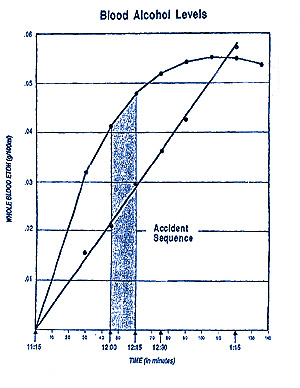RUNGE-KUTTA ALGORITHM:
Simulation of Blood Alcohol Concentrations
As A Function of Time Following Simultaneous
Ingestion of Alcohol With Solid Food - [ISBN 0-9621181-9-2 ]
$22.95 (US)
( 385 Pages )
 A lawsuit was filed by Plaintiffs in 1987 for damages, alleging negligence against the County of Imperial, California, City of Calexico, California, and the Imperial Irrigation District. The litigation arose out of an off-road motorcycling accident occuring in the city of Calexico in which Plaintiff sustained serious injuries including facial bone fractures, a ruptured carotid artery, broken teeth, blood clots and neurological damage. A lawsuit was filed by Plaintiffs in 1987 for damages, alleging negligence against the County of Imperial, California, City of Calexico, California, and the Imperial Irrigation District. The litigation arose out of an off-road motorcycling accident occuring in the city of Calexico in which Plaintiff sustained serious injuries including facial bone fractures, a ruptured carotid artery, broken teeth, blood clots and neurological damage.
Defendants alleged as an affirmative defense that the Plaintiff was intoxicated at the time of the accident and that the Plaintiff’s intoxication was the proximate cause of his injury. Their defense was based on a measurement of blood alcohol concentration of 0.08 percent (gram/100 cc) from a blood sample drawn from Plaintiff at the Hospital Emergency Receiving Department to which Plaintiff was brought for treatment approximately one-hour subsequent to the accident. Defendants argued that they were entitled to rely on a presumption that the blood alcohol concentration at the time of the accident was 0.08 percent (g/100 cc), based on California Vehicle Code Section 23152(b) which creates a rebuttable presumption that Plaintiff had 0.08 gram/100 cc alcohol in his blood at the time of driving the motorcycle if he had 0.08 gram/100 cc of alcohol in his blood at the time of performance of a chemical test within three hours after the driving.
The Plaintiff maintained however that approximately 60-90 minutes prior to the accident, that he had enjoyed a lunch consisting of a few sandwiches and a “couple of beers”. It is commonly accepted in the scientific community that the simultaneous ingestion of food and alcohol results in a significantly delayed absorption of alcohol into the bloodstream, either delaying the time to occurrence (Tmax) of the peak (maximal) concentration of blood alcohol following a single episode of alcohol ingestion, or reducing the magnitude of the maximum alcohol concentration (Cmax) attained, or both. The accident occurred approximately 60 minutes subsequent to alcohol ingestion whereas the Plaintiff’s blood alcohol concentration was measured approximately 120 minute subsequent to alcohol administration. If alcohol absorption was significantly delayed due to concomitant ingestion of food, thus increasing Tmax and reducing Cmax, then the blood alcohol concentration at the time of the accident could be significantly less than the blood alcohol concentration measured at the time of hospital admission. Hence the statutory presumption alluded to previously as Vehicle Code Section 25152(b) would be invalidated. The deposition and trial testimony of Howard Mehler included in Part B of this e-report and the exhibits appended thereto provide a clear example of the application of a Third Order Runge Kutta Algorithm for simulation of blood alcohol concentrations as a function of time following simultaneous ingestion of liquid alcohol with solid food. The results of this computer simulation provide clear and convincing evidence that Plaintiff’s blood alcohol concentration at the time of the accident was significantly lower than the blood alcohol concentration measured on hospital admission, effectively rebutting the statutory presumption of intoxication.
| CONTENTS |
| |
A. Case Synopsis |
| |
B. Testimony of Howard S Mehler |
| |
1. Deposition Transcript
2. Trial Transcript
C. Runge Kutta Simulations
D. Foundation for the Use of the Runge Kutta Algorithm |
$22.95 (US)
( 385 Pages )
|
|